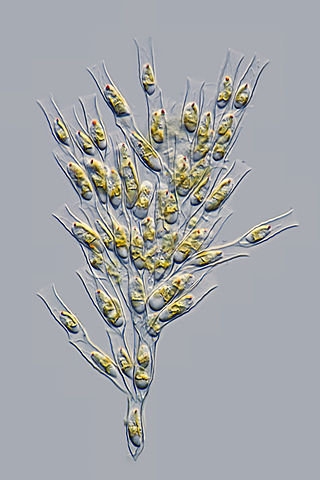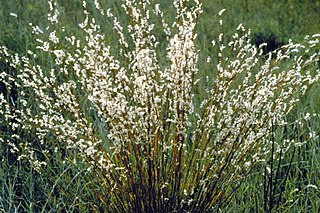
Chlorophyta or Prasinophyta is a taxon of green algae informally called chlorophytes. The name is used in two very different senses, so care is needed to determine the use by a particular author. In older classification systems, it refers to a highly paraphyletic group of all the green algae within the green plants (Viridiplantae) and thus includes about 7,000 species of mostly aquatic photosynthetic eukaryotic organisms. In newer classifications, it refers to the sister clade of the streptophytes/charophytes. The clade Streptophyta consists of the Charophyta in which the Embryophyta emerged. In this latter sense the Chlorophyta includes only about 4,300 species. About 90% of all known species live in freshwater. Like the land plants, green algae contain chlorophyll a and chlorophyll b and store food as starch in their plastids.

The Russulales are an order of the Agaricomycetes,. According to the Dictionary of the Fungi, the order consists of 12 families, 80 genera, and 1767 species. According to Species Fungorum, the order contains 13 families, 117 genera, and 3,060 species.

The Chrysophyceae, usually called chrysophytes, chrysomonads, golden-brown algae or golden algae are a large group of algae, found mostly in freshwater. Golden algae is also commonly used to refer to a single species, Prymnesium parvum, which causes fish kills.

The order Cephalaspidea, also known as the headshield slugs and bubble snails, is a major taxon of sea slugs and bubble snails, marine gastropod mollusks within the larger clade Euopisthobranchia. Bubble shells is another common name for these families of marine gastropods, some of which have thin bubble-like shells. This clade contains more than 600 species.

Incertae sedis or problematica is a term used for a taxonomic group where its broader relationships are unknown or undefined. Alternatively, such groups are frequently referred to as "enigmatic taxa". In the system of open nomenclature, uncertainty at specific taxonomic levels is indicated by incertae familiae, incerti subordinis, incerti ordinis and similar terms.

Eurotiomycetes is a large class of ascomycetes with cleistothecial ascocarps within the subphylum Pezizomycotina, currently containing around 3810 species according to the Catalogue of Life. It is the third largest lichenized class, with more than 1200 lichen species that are mostly bitunicate in the formation of asci. It contains most of the fungi previously known morphologically as "Plectomycetes".

The Andropogoneae, sometimes called the sorghum tribe, are a large tribe of grasses (family Poaceae) with roughly 1,200 species in 90 genera, mainly distributed in tropical and subtropical areas. They include such important crops as maize (corn), sugarcane, and sorghum. All species in this tribe use C4 carbon fixation, which makes them competitive under warm, high-light conditions.

Cirrina or Cirrata is a suborder and one of the two main divisions of octopuses. Cirrate octopuses have a small, internal shell and two fins on their head, while their sister suborder Incirrina has neither. The fins of cirrate octopods are associated with a unique cartilage-like shell in a shell sac. In cross-section, the fins have distinct proximal and distal regions, both of which are covered by a thin surface sheath of muscle.

Ensifera is a suborder of insects that includes the various types of crickets and their allies including: true crickets, camel crickets, bush crickets or katydids, grigs, weta and Cooloola monsters. This and the suborder Caelifera make up the order Orthoptera. Ensifera is believed to be a more ancient group than Caelifera, with its origins in the Carboniferous period, the split having occurred at the end of the Permian period. Unlike the Caelifera, the Ensifera contain numerous members that are partially carnivorous, feeding on other insects, as well as plants.

Pygidicranidae is a family of earwigs, formerly placed in the suborder Forficulina, now in the suborder Neodermaptera. The family currently contains twelve subfamilies and twenty six genera. Eight of the subfamilies are monotypic, each containing a single genus. Of the subfamilies, both Astreptolabidinae and Burmapygiinae are extinct and known solely from fossils found in Burmese amber. Similarly Archaeosoma, Gallinympha, and Geosoma, which have not been placed into any of the subfamilies, are also known only from fossils. Living members of the family are found in Australia, South Africa, North America, and Asia. The monotypic genus Anataelia, described by Ignacio Bolivar in 1899, is found only on the Canary Islands. As with all members of Neodermaptera, pygidicranids do not have any ocelli. The typical pygidicranid bodyplan includes a small, flattened-looking body, which has a dense covering of bristly hairs (setae). The pair of cerci at the end of the abdomen are symmetrical in structure. The head is broad, with the fourth, fifth and sixth antenna segments (antennomeres) that are not transverse. In general Pygidicranids also have equally sized ventral cervical sclerites, and in having the rearmost sclerite separated from, or only touching the center of the prosternum. Cannibalism of young has been observed in at least one species in the family, Challia hongkongensis, in which an adult female was found eating a still-living nymph of the same species. The same species in a different area has been observed possibly eating fruits or seeds, making the species an omnivore.

Stylonurina is one of two suborders of eurypterids, a group of extinct arthropods commonly known as "sea scorpions". Members of the suborder are collectively and informally known as "stylonurine eurypterids" or "stylonurines". They are known from deposits primarily in Europe and North America, but also in Siberia.

Merycoidodontoidea, sometimes called "oreodonts" or "ruminating hogs", is an extinct superfamily of prehistoric cud-chewing artiodactyls with short faces and fang-like canine teeth. As their name implies, some of the better known forms were generally hog-like, and the group has traditionally been placed within the Suina, though some recent work suggests they may have been more closely related to camels. "Oreodont" means "mountain teeth", referring to the appearance of the molars. Most oreodonts were sheep-sized, though some genera grew to the size of cattle. They were heavy-bodied, with short four-toed hooves and comparatively long tails.

Incirrata is a suborder of the order Octopoda. The suborder contains the classic "benthic octopuses," as well as many pelagic octopus families, including the paper nautiluses. The incirrate octopuses are distinguished from the cirrate octopuses by the absence in the former of the "cirri" filaments for which the cirrates are named, as well as by the lack of paired swimming fins on the head, and lack of a small internal shell.

The Phasmatidae are a family of the stick insects. They belong to the superfamily Anareolatae of suborder Verophasmatodea.

The Pleosporales is the largest order in the fungal class Dothideomycetes. By a 2008 estimate it contains 23 families, 332 genera and more than 4700 species. The majority of species are saprobes on decaying plant material in fresh water, marine, or terrestrial environments, but several species are also associated with living plants as parasites, epiphytes or endophytes. The best studied species cause plant diseases on important agricultural crops e.g. Cochliobolus heterostrophus, causing southern corn leaf blight on maize, Phaeosphaeria nodorum causing glume blotch on wheat and Leptosphaeria maculans causing a stem canker on cabbage crops (Brassica). Some species of Pleosporales occur on animal dung and a small number occur as lichens and rock-inhabiting fungi.
The Rhodogorgonales are an order of red algae, a sister group to the corallines. They are always thalloid and calcified; their calcification is very different from the corallines, as individual calcite crystals are deposited in the cell wall of specialised cells; this suggests that the evolution of calcification may have been independent from the corallines. They have no fossil record.

The extinct Solenoporaceae have traditionally been interpreted as a group of red algae ancestral to the Corallinales.
Wetheredella is a genus of calcimicrobes initially described from the Silurian of England, and subsequently reported from the Upper Ordovician to the end of the Carboniferous periods; its reefs are stated as being characteristic of the Ordovician-Silurian periods. Its taxonomic position is uncertain; it has been suggested to be a foraminiferan, a cyanobacterium or simply treated as a microproblematicum; Vachard & Cózar (2010) refer it to the Algospongia, a similarly controversial group that they assigned to the Protista but later, per Vachard, 2021, to Algae incertae sedis, in its own family and suborder (Wetheredellina) in the order Moravamminida. The genus is named in honor of the geologist Edward Wethered.

Errantia is a diverse group of marine polychaete worms in the phylum Annelida. Traditionally a subclass of the paraphyletic class Polychaeta, it is currently regarded as a monophyletic group within the larger Pleistoannelida, composed of Errantia and Sedentaria. These worms are found worldwide in marine environments and brackish water.

Ovalentaria is a clade of ray-finned fishes within the Percomorpha, referred to as a subseries. It is made up of a group of fish families which are referred to in Fishes of the World's fifth edition as incertae sedis, as well as the orders Mugiliformes, Cichliformes, and Blenniiformes. It was named by W. L. Smith and T. J. Near in Wainwright et al. (2012) based on a molecular phylogeny, but the authors suggested that the group was united by the presence of demersal eggs that are attached to a substrate. Some authors have used the ordinal name Stiassnyiformes for a clade including Mugiloidei, Plesiopidae, Blenniiformes, Atherinomorpha, and Cichlidae, and this grouping does appear to be monophyletic.

















